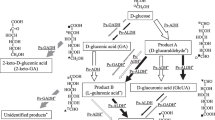Summary
Phosphoketolase activity from nine yeasts grown on xylose occurred with both xylulose 5-phosphate (Xu5P) and ribulose 5-phosphate (Ru5P) as substrates. With extracts from five yeasts (Candida curvata, C. famata, Lipomyces starkeyi, Rhodotorula glutinis and Pachysolen tannophilus) activity was approximately the same with either substrate; with C. boidinii, Pichia media and Yarrowia lipolytica Ru5P was the preferred substrate; and with Rhodosporidium toruloides Xu5P was the better substrate. Partial purification of the phosphoketolase from C. famata was attempted: although activity of phosphoketolase towards Ru5P was decreased it was not eliminated and it is concluded that either (i) the phosphoketolase does have dual substrate specificity, in which case it should be referred to as a pentulose-5-phosphate phosphoketolase (Pu5PPK) or (ii) Ru5P-3-epimerase activity, which can interconvert Xu5P and Ru5P, may be closely associated with phosphoketolase activity. The Pu5PPK has a \(K_{\hat m}\) of 2.4mm for Xu5P, a pH optimum of 7.2–7.4 and a M r of 5x105 daltons. It is not sensitive to inhibition by citrate or acetyl-CoA at physiological concentrations.
Similar content being viewed by others
References
Bruinenberg PM, deBot PHM, van Dijken JP, Scheffers WA (1983) The role of redox balances in the anaerobic fermentation of xylose by yeasts. Eur J Appl Microbiol Biotechnol 18:287–292
Evans CT, Ratledge C (1983) A comparative study of citrate efflux from mitochondria of oleaginous and non-oleaginous yeasts. Eur J Biochem 130:195–204
Evans CT, Ratledge C (1984) Induction of xylulose-5-phosphate phosphoketolase in a variety of yeasts grown on d-xylose: the key to efficient xylose metabolism. Arch Microbiol 139:48–52
Goldberg M, Fessenden JM, Racker E (1966) Phosphoketolase. In: Wood WA (ed) Methods in enzymology, vol 9 Academic Press, New York, pp 515–520
Gong CS (1983) Recent advances in d-xylose conversion in yeasts. Ann Rep Ferment Proc 6:253–297
Heath EC, Hurwitz J, Horeker BL, Ginsburg A (1958) Pentose fermentation by Lactobacillus plantarum I The cleavage of xylulose 5-phosphate by phosphoketolase. J Biol Chem 231:1009–1029
Williamson WT, Wood WA (1966) d-Ribulose 5-phosphate 3-epimerase. In: Wood WA (ed) Methods in enzymology, vol 9 Academic Press, New York, pp 605–611
Author information
Authors and Affiliations
Rights and permissions
About this article
Cite this article
Ratledge, C., Holdsworth, J.E. Properties of a pentulose-5-phosphate phosphoketolase from yeasts grown on xylose. Appl Microbiol Biotechnol 22, 217–221 (1985). https://doi.org/10.1007/BF00253613
Received:
Issue Date:
DOI: https://doi.org/10.1007/BF00253613



